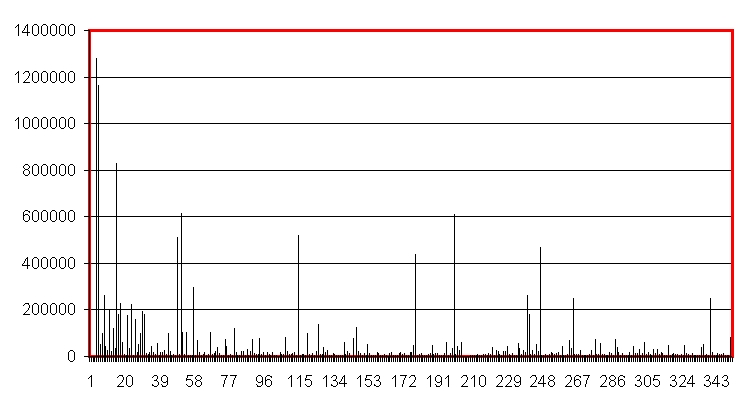
Candidate Obama promised to change the relationship between government and the people. When he was inaugurated one shorthand way to translate that change became 'transparency.' Hardly a paragraph could be spoken in the first six weeks without invoking transparency. Transparency was in -- at least at the beginning of the new administration.
Transparency can be many things. The information technology bloggers are excited that government collected information is going to be available via APIs. Civil libertarians are hopeful that tranparency will mean the end to warrantless spying on the public and to secret contracts with murders for hire.
My interest is in the public face of transparency; in what transparency becomes when addressing the citizenry. I have just finished a book on the YouTube campaign of 2008 where the Obama campaign used video placed on YouTube quite effectively. The YouTube presidency seemed an obvious next step for them and for me. YouTube is not the only public communication being utilized by the Obama people. There are also websites; Reality Check is being used in the fight for health care reform, for example. They are also using Facebook and other social networks, and there is much essentially private communication via email and other forms of messaging, as well. But YouTube was an important component of their public communication during the election, and I thought it would be a good idea to see how they followed up on what they had done in winning office.
Between January 20 and August 8 of 2009 the Obama administration uploaded 349 videos to YouTube on the White House channel. In this analysis I will ignore the two that were eventually taken down and include all of the duplicates that were different only by the language of the closed captioning. Before 2005 the internet did not have enough bandwidth to support substantial use of video communication, and YouTube and other video aggregation sites did not exist. YouTube was founded in 2005; while it is not the only video aggregation site on the web it is far and away the largest and busiest. Thus, the Obama administration is the first presidency that might effectively use its own video instead of being completely beholden to network news.
 |
Views per video January 24 through August 7 |
President Obama's inaugural speech and his first weekly address on January 24 are far and away the most frequently viewed videos the administration has put on YouTube; on the White House channel the inaugural address was viewed 1.3 million times and the first weekly address was viewed almost 1.2 million times [See Counts]. One might say, it has been all downhill from there. The downward trend is clearer when you add a trend line. In this case the first two, more than a million views, videos were left out of the figure to keep the trend within reason.
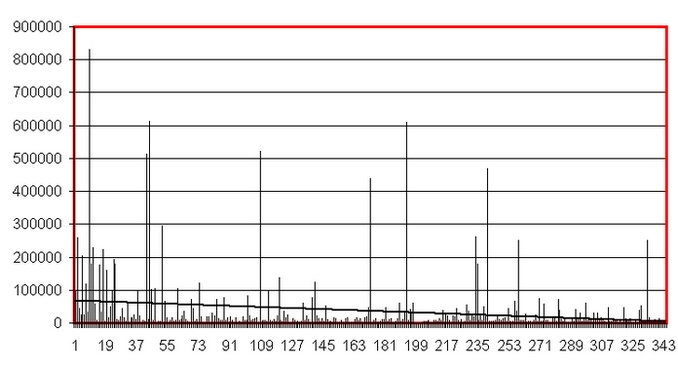 |
Trend Line January 29 August 7 |
Most of the videos barely show because they were viewed so many times fewer than the first videos in the figure. Their number of views is too small to show up.
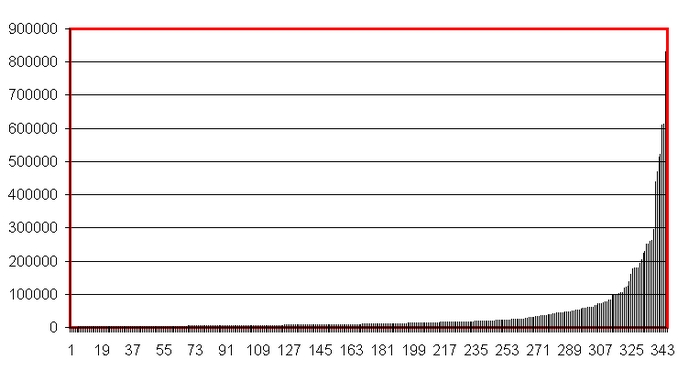 |
Distribution sorted by number of views |
As is obvious in the first two figures the distribution is highly skewed -- even when you leave out the two more than a million views videos. There are a few that are viewed many times, and most are viewed, comparatively, few times.
One other distribution of the total set of videos is notable. The research covers the first 28 weeks of the Obama administration. The number of videos per week is plotted on time in this figure.
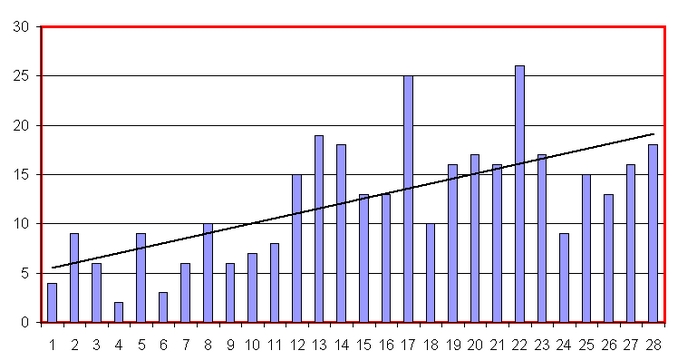 |
Videos per week |
The first week there were only four videos. With some irregularity the trend is up -- more videos per week.
At the same time the views per video was going down the number of videos was increasing.
If transparency means pointing a video camera at the administration and keeping it turned on then transparency is about to arrive. Three videos a day, which is what it is approaching, should be sufficient to exhaust even the most dedicated fan. But what is transparency if almost no one is watching? Sorting the videos by number of views the bottom half average only about 5,000 views. The bottom eighty percent average only about 10,000 views. Those are not big numbers, but we really do not have much frame of reference. What should we think of as big and small? The mean for all videos posted by the White House is 44,904. But it does not answer the question: what is transparency when there are only 5 or 10 thousand views per video, which is eighty percent of the videos?
Rewriting
When I proposed this paper I assumed we would be learning interesting ways new media could be used to foster outside the beltway politics that would change the structure of inside the beltway politics. The Obama campaign had used new media very effectively in winning the election. So, the question was: how would they use new media outside the beltway in winning inside the beltway? By March it seemed pretty clear that they did not have a plan that would bring outside the beltway into the beltway. So, I have thought, for months, I was going to be a lone voice of doom and gloom. My punchline was going to be: from charismatic candidate to just another suit. That was the paper I was writing until last week. But prophets of doom and gloom have been popping up like dandelions in early spring. They are out and about as far as the eye can see. George Lakoff says the Obama administration is deficient in framing the health care battle. Paul Krugman says they are not able enough at inside the beltway politics. The Republicans have found that fear mongering works outside the beltway. And neither the administration nor the news media have had an answer to that.
I am not interested in participating in an echo chamber. I will not say what everyone else is saying even if I could argue that I got there well before they did. So I did an electronic version of tearing up what I was writing and started over again.
After being so fully committed to doom and gloom it was hard to think something else, but I am back to my original question. What can we learn from the Obama administration about using new media to do successful outside the beltway politics? They have not been very successful, but there have been successes. So I want to look at the successes, and develop an understanding of how they managed the successes when they did.
How charisma fades
Mr. Obama was a charismatic candidate. Wherever he traveled during the campaign the enthusiasm of his supporters was 'over the top.' Twice as many of his supporters were enthusiastic about their choice as was true of McCain supporters. A million traveled to Grant Park election night to celebrate his victory. Millions traveled to Washington D.C. to participate in his inauguration and what they believed would be the beginning of a new politics.
He started with a high coming out of the campaign that was not matched by many other candidates. The question is how long would the high last and how would it fade?
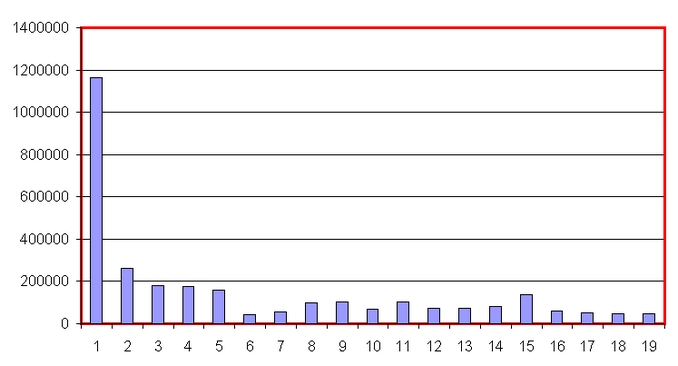 |
Number of views per weekly address January 24 through May 23 |
The inauguration was January 20 and he gave his first weekly address on January 24. Like presidents before him he has done a weekly address to the nation every Saturday of his presidency. The only real difference is adding video; it is on the White House channel on YouTube instead of being a radio address. That first weekly address was viewed almost 1.2 million times. That is enthusiasm -- though I will come to at least one other political video on YouTube that also reached that figure. Week two the views fell to about 260,000. Week three views were 180,000, week four 177,000, week five 160,000. Then the bottom fell out. In week six the weekly address was viewed only 45,000 times. From February 27, week five, through May 23, week 19, the average number of views per address was 53,000.
It seems safe to say charisma was exhausted by week six. We know that few people listened to presidents' weekly radio addresses though we do not have numbers that are nearly as good as these. Fifty thousand is down to the most dedicated political types.
I am not saying the enthusiasm among president Obama's supporters had disappeared by February 27. I am saying that the enthusiasm that earlier led them to YouTube to view the weekly address had faded. And that was, I believe, a bad sign for bringing outside the beltway politics into the beltway.
Charisma works, but charisma that is not kept alive seems to fade quickly.
Here's one for my true fans
Mr Obama had an unprecedented level of support among young people and new voters in the 2008 election. He won the votes of those under 30 by an impressive 66% to 31%, much higher than in any previous election. (Schifferes)
The true fans were the under thirties, and it did not stop at the voting age. Some of his most enthusiastic fans were 15 or 16 years old. He appealed to the young in an extraordinary way. They even voted for a change; at least a bit more than usual.
What has the Obama administration done for the young? Health care reform? They are, in general, that portion of the population least in need of health care. They are healthy. Cars for clunkers? That is getting closer, but most of them either have a new car or they cannot afford to trade in their clunker for a new car. Spending billions on infrastructure? That is a long way from central to the imagination of most young people? Reviving banks? And the list goes on. The Obama administration has been very busy. But you would never know that teenagers had been an important part of their electoral base.
Obama did what many other presidents have done that could appeal to the young. He helped athletic teams celebrate their victories. This is the list of teams who had visited him at the White House by August 8.
Team |
Views |
| Florida Gators | 19,120 |
| Pittsburgh Steelers | 16,338 |
| Tar Heels: mens' basketball | 12,627 |
| Philadelphia Phillies | 12,131 |
| Connecticut Huskies: womens' basketball | 9,784 |
| Detroit Shock | 6,828 |
Those are not very impressive numbers. Apparently, it makes the individuals on the teams feel very good about visiting with the president, but not many fans show up.
However, there was "Shoot Around with the Lady Huskies." The president shot hoops with the womens' championship basketball team. And if one believes the video he did very well. That video was viewed 521,000 times!
Listen to the teenagers exclaim and stream to YouTube to see their man Barack Obama shooting hoops. A blast.
The date is worth noting: April 28. By that point the views of the weekly addresses had fallen to roughly 50,000. Five hundred thousand was a very big deviation from the general pattern; it is one of the 'spikes' in the first figure.
I am not suggesting that every president should practice basketball skills. The point here is:
"Did you see that?" was the refrain. No one really expected him to do that. But this is a case where both constituency and unexpected came together, and it generated ten times the average number of views. It brought outside the beltway back -- even if only briefly.
Let them know it's coming
If you want to get their attention you had better remember that unlike people inside the beltway those living outside the beltway do not eat, sleep and breath politics; it is not central in most peoples' lives. They need something to get their attention when you want to involve them.
That was what BarackObamadotcom was to be about. The campaign for the presidency was organized by BarackObamadotcom. That was their channel on YouTube, and that was how they identified themselves. After the election BarackObamadotcom was not disbanded. It had an email list of 13 million and it had connections with the politically active and with political donors all over the country. BarackObamadotcom was going to be the outside the beltway [and not government] arm of the administration.
During the winter of 2008-2009 the collapse of the global financial system was the top problem facing the US and other governments. First, the Bush administration started action. Then the Obama administration essentially continued on the same path. That did not 'solve' the problem, but it did prevent total collapse. By the spring of 2009 the chief problem had become the economy. It was in deep depression, and something needed to be done to keep it from going into total melt down.
On March 17 the president addressed the nation via YouTube with "A New Foundation for Growth." This was his answer to what could be done. At least 13 million received an email from BarackObamadotcom saying: click here and listen to the president talk about his plan for the economy. The result was the video was viewed 513,189 times. Since views of the weekly address was falling precipitously at this same time 500,000 views was a great accomplishment.
In the summer the economy was still an important concern and high on the agenda of politicians. Since we believe in instant gratification there was widespread concern that the actions of the Obama administration had not brought the recovery we were all hoping for. President Obama wanted to reduce the political damage, and he had the numbers to do it. That produced "President Obama Speaks on New GDP Numbers," which was a video posted to YouTube on July 31. It was viewed 5457 times.
Five hundred thousand to five thousand is a considerable fall off. It is not the case that there was less concern about the economy in the summer than in the spring. So it must have been something else. Unless I missed the email, outside the beltway was not warned that something was coming. If you were following the White House channel on YouTube carefully you might have run into it. But then there is GDP. Many people in the country do not know what GDP is about. If you want them to know that this is about economic recovery you probably need to have the words economic recovery in the title, and you probably do not need numbers in the title since there are lots of number-phobes in this country.
One more case I cannot pass up
After a long summer of fear mongering by Republican politicians and their allies, and their egging on even more egregiously false claims and shreiking hatred in town hall meetings across the nation the president gave it one more go. "Myths and morality in health insurance reform" was his weekly address on August 21. In the unusually long 6:33 length video he set out to counter the mis-truths and misunderstandings that seemed rampant in the debate and to give a statement of the moral imperative for the reform.
Just a couple of days earlier Barney Frank was in one of those contentious town hall meetings like the others being reported daily in the news. An attractive young woman stood up holding a picture of Obama decorated as Hitler and asked why Barney Frank would support a Nazi program like the president proposed. He let her have it with both barrels, as the saying goes. He began with "what planet have you been living on?" Said that only the first amendment made possible the horror she was speaking. And ended with "talking with you is like talking to a dining room table. I don't want to do it." Which was followed by cheers from the audience. Barney Frank is an adroit politician so CNN was there. Within seconds the video clip of the exchange was up on YouTube, and Larry King was asking his guest to look at it with him.
The result: Obama countering mistruths and misunderstandings 46,000 views by day four. Barney Frank countering mistruths and misunderstandings 1.2 million views by day four.
What are we going to make of the disparity in viewing the two video clips?
One, audience: the democrats outside the beltway felt themselves and the program they wanted so much under attack in the most vicious and false manner. They were desperate for a hero who would stand up and say loudly and clearly --BULLSHIT. They wanted the opposition put in their place. We know that disgruntled Democrats were flocking to view the video by where they were coming from -- 240,000 came from The Huffington Post, which is the home of liberal Democrats on the web. We know how they were feeling from their comments via Twitter. "Rep. Barney Frank saying EXACTLY what I'm feeling." "Barney Frank puts RW nut in her place." "If only the other liberal democrats could grow a pair, we might actually get some health reform." They were hungry for someone to publicly express their anger at what the health care debate had become. Barney Frank did it. Barack Obama did not.
Two, the question from the audience: She did not look like a right wing nut. She was young, she was very attractive. But what she said was so far beyond the pale that it is hard to imagine any except an extraordinarily tiny fraction of the public taking this seriously. She attractively presented a 'truth' that was so far out that no one could doubt how Barney Frank would characterize it. There was no room for weazeling here on the part of the Republican opposition; even Charles Grassley would have to concede.
Three, confrontation: Republicans had been slamming the program of these Democrats all summer. It had been confrontational politics, but only one side was doing the confronting. As Schattschneider famously said, when you start a fight you draw a crowd. Barney Frank engaged and drew a crowd.
Four, Barney Frank: He did it. He put her down forcefully, in a few measured words, and with humor. They became happy Democrats for they not only had a hero who put down the opposition, they also had a good laugh in his doing it.
What the Republicans had been practicing was Schattschneider 1.0. When you start a fight you draw a crowd, and that changes the distribution of support and opposition. The Democratic politicians, including the president, had been sitting on their hands. It was not silence, but it was a refusal to engage in the fight. Barney Frank entered the ring and scored one for the liberal democrats outside the beltway.
Conclusions
What conclusions might one draw from this brief examination of successful outside the beltway political communication?
These are homilies that any communication scholar could rattle off without much thought. Fans of the Obama administration will be saddened that they were forgotten in the move from candidate to office.
Notes
Counts: the paper has information on all of the videos uploaded to the White House channel on YouTube between January and August 8, but the count of the number of views of the videos was from August 21. Since most of the views of a video occur in the first two weeks they are on YouTube it seemed appropriate to take the counts two weeks after the last video to be considered was posted.
Steve Schifferes, Who Voted for Obama?, BBC News, November 5, 2008.